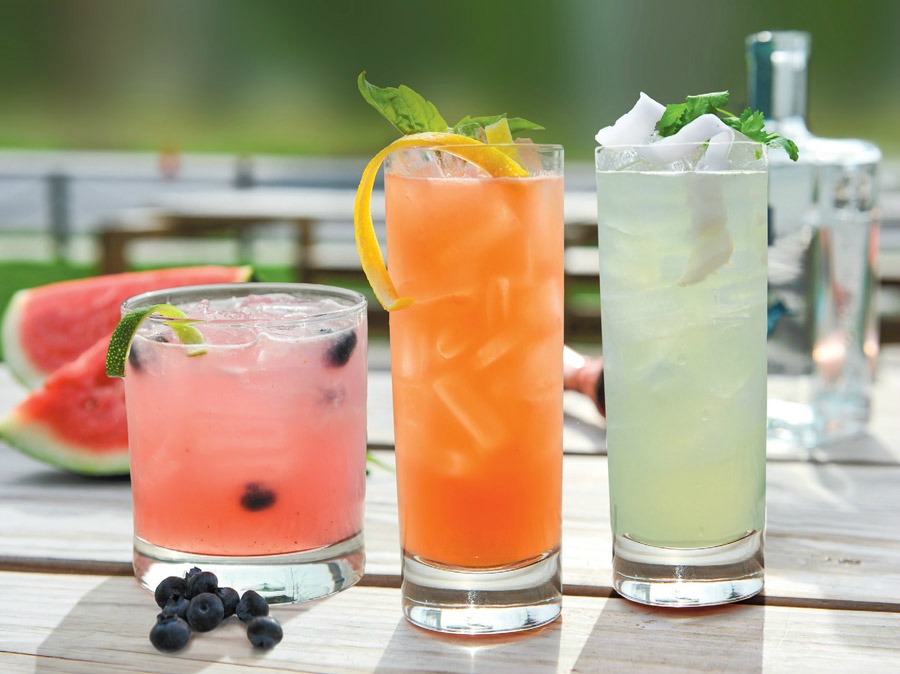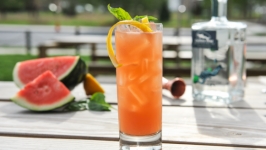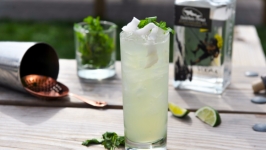Craft Cocktails Hit the Beach
Craft cocktails are taking the beach by storm!
In spring, the culinary world turned a collective eye toward Delaware. After seven nominations, Sam Calagione was named the “Outstanding Wine, Spirits, or Beer Professional” by the James Beard Foundation. Many people see the colorful Calagione as a guru of craft beer. That’s not surprising. He founded Dogfish Head Craft Brewery in 1995. But the entrepreneur has also made a stir in the spirits sector, and Dogfish Head Distilling Co.’s products are on prominent display at Chesapeake & Maine in downtown Rehoboth Beach.
Located next to Dogfish Head Brewings & Eats, Chesapeake & Maine is just over a year old. But the bar program was also nominated for a James Beard Award. “The cocktail program at Chesapeake & Maine is the most adventurous you’ll find in Delaware,” Calagione maintains. At a three-course dinner to highlight Dogfish Head’s new whiskeys and single malts, Chesapeake & Maine offered such cocktails as Rockin’ in the Grain, made with Dogfish Head un-aged four-grain single-malt whiskey, grated nutmeg and a Meyer lemon-thyme sour.
However, the restaurant is not the only coastal hotspot serving up craft cocktails. “Our palates are maturing,” says Hari Cameron, chef and owner of a(MUSE.), who's received a James Beard Award nomination. “Increasingly, people appreciate bitter flavors, floral flavors and cocktails that are more alcohol-driven.”
Along the coast, vacationers are looking to indulge and experiment. “They want to order something fun with local flavor,” says Ginger Breneman, the manager of the bar program at Fork + Flask at Nage on Route 1 in Rehoboth. Fork + Flask is proof of the trend. Originally Nage Bistro & Wine Bar, the restaurant changed its name in 2016. Along with a beachy ambiance, the longtime establishment received an expanded U-shaped bar that puts the limelight on the bartenders. “We’ve been known for espresso martinis, gimlets, and cocktails with blueberry lemonade, even though we called ourselves a wine bar,” says Josh Grapski. “Craft cocktails are a natural for a bigger bar.”'
The restaurant went from about 125 bottles of wine down to 75, with the emphasis being on unique selections. Meanwhile, the beverage menu now features nearly 20 signature cocktails at any given time. Although the menu’s price point has dropped in keeping with the more casual atmosphere, the sale of craft cocktails and food at the bar has boosted revenue.
So, what is a craft cocktail? “They have raw, fresh ingredients and are made with various processes,” says Breneman, who previously owned Mixx, a restaurant known for its martinis. “You use sodas and bar tools, such as double strainers or a muddler, which most bars don’t have.”
The classics are new again. Customers are often surprised when Breneman slips an egg white into the shaker for a Pisco Sour, which also includes St. Germain (a liqueur made with elderflowers), fresh lime juice and a sprinkle of Angostura bitters. But that’s a key element of the drink, which originated in Peru. The unusual is becoming more accepted. Breneman, for instance, likes to incorporate herbs and spices. For a cocktail contest featuring Dogfish Head spirits—held at Fork + Flask earlier this year—she served a cocktail inspired by an Arnold Palmer. (The non-alcohol version is half lemonade and half iced tea.) Her version had ginger, habanero, green tea, lemon and sugar, along with the Dogfish Head’s Analog Vodka. For a dessert martini, she’s used peanuts to mimic the flavor of Reese’s candy.
The creative license involved with craft cocktails appeals to Cameron, who’s considered a culinary alchemist. He frequently enters cocktail contests. Winston Churchill and the old corpse reviver cocktail served inspired a submission for a Bombay Sapphire competition. The traditional Corpse Reviver #2, which was considered a cure for a hangover, is made with gin, Cointreau, Lillet Blanc (a French aperitif wine), lemon juice and absinthe. Since Churchill favored Lapsang Souchong, a smoked black tea, Cameron atomized cold infused gin and the tea to give it a smoky profile. He used grapevine wood from Nassau Valley Vineyard to smoke vermouth. He made a syrup using locally forged Juniperus virginiana, the local strain of juniper, spruce tips and some lavender from Lavender Fields in Milton. Instead of a sweet orange-flavored liqueur, he used dry. “It complemented the flavor of the Bombay Sapphire,” he explains. Then he added eight drops of acid phosphate to the drink for a bright flavor. Such concoctions usually make it onto the a(MUSE.) menu under “Hari’s Featured Cocktail.”
Traditional culinary ingredients (apple, tarragon, honey, maple syrup) also make it into the cocktails at Chesapeake & Maine, which is not surprising considering Dogfish Head has been doing that with its beers since its start. The brewpub is often a testing ground for oneoff and new beers. Chesapeake & Maine is serving as that platform for the spirits line. Currently, it’s the only place where you can try the new whiskeys and single malts.
“Our goal is to expand our footprint outside of the MidAtlantic to match our beer distribution,” Calagione says of the distilling line. “Our bar program at Chesapeake & Maine is our R&D lab and incubator for new and innovative spirits.” There are more than a few visitors and locals who are happy to serve as guinea pigs.








